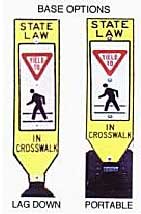Researchers
Reginald Souleyrette
Ed Kannel
About the research
The Traffic Engineering Department of Cedar Rapids, Iowa, a city of approximately 125,000 people, frequently received letters expressing concern for pedestrian safety at key non-controlled intersections. The city has 21 designated pedestrian crosswalks at non-intersection, non-school, and non-trail crossings, as well as numerous uncontrolled intersections. In 2002, the Cedar Rapids City Council gave preliminary approval to implement a pedestrian-actuated overhead flasher system and an in-pavement flasher system. However, before proceeding with these projects, the Cedar Rapids Traffic Engineering Department sought assistance from the Iowa Department of Transportation to evaluate a lower cost option, an in-street flexible sign to remind motorists of their obligation to yield to pedestrians.
This report summarizes the results from a small-scale study to evaluate the effect of an experimental in-street sign, State Law -Yield to Pedestrians in Crosswalk. Three sites with widely different characteristics were selected by the city, and the Center for Transportation Research and Education at Iowa State University provided a small-scale assessment. Although only two of the sites were open to normal traffic flow during the study period, all sites are generally discussed in this report.
The State Law –Yield to Pedestrian sign has had a positive impact on driver behavior, although the effect is not dramatic in all applications. The Cedar Rapids experience is similar to other studies examined in the literature. Speed reductions at one site and improved driver compliance at another were identified. However, the changes are not uniform throughout. In particular, at First Avenue East and 4th Street NE, the location of the major crosswalk with respect to the competing demands for attention (railroad crossing, bike path, and intersection) appears to affect the degree to which drivers adjust their driving habits. If drivers perceive that their own safety is jeopardized, compliance with the sign message will be diminished.
